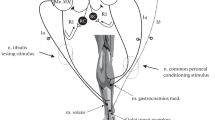Summary
The pattern of recurrent inhibition to motoneurones (MNs) innervating different lower limb muscles was investigated in ten healthy subjects. Three complementary experimental designs, all based on the electrophysiological method introduced by Bussel and Pierrot-Deseilligny in 1977, were used in Quadriceps (Qu), Pretibial (Pt), Soleus (Sol) and Abductor hallucis (Abh) motornuclei: 1) measurement of the relationship between the amplitude of conditioning H (H1) and test (H′) reflexes; 2) measurement of the effect of the intravenous administration of L-Acetylcarnitine (L-Ac) on the amplitude of the test H′ reflex after a constant H1 conditioning reflex; 3) measurement of the modifications of the test H′ reflex in relation to a reference H (Ref H) reflex during a weak tonic voluntary contraction of the homonymous muscle. A complete agreement among results obtained with the different experimental paradigms was observed. Similarly to the Sol, both Pt and Qu MNs were found to be recurrently inhibited: a) the test H′ reflex exhibited a progressive and consistent depression with increasing amplitude of the H1 conditioning reflex beyond a specific value; b) an additional decrement of the test H′ reflex was obtained after intravenous administration of L-Ac; c) a decrease in the size of the test H′ reflex, with respect to its value at rest, was observed during a weak tonic voluntary contraction, in spite of the enhanced MN excitability (as shown by the increase in the Ref H). By contrast, no evidence of recurrent inhibition to the Abh MNs was found. The amplitude of the test H′ reflex showed no further depression with increasing conditioning reflex discharge, L-Ac administration or during weak voluntary contraction. It is concluded that in the lower limb, MNs acting on the knee and ankle muscles receive recurrent inhibition, but that this is lacking in motornuclei innervating the more distal muscles, such as the intrinsic foot muscles. Some methodological and physiological implications are discussed in relation to the present findings.
Similar content being viewed by others
References
Baldissera F, Hultborn H, Illert M (1981) Integration in spinal neuronal systems. In: Brooks VB (ed) Handbook of physiology, Sect 1. The nervous system, Vol 2. Motor control. Am Phys Soc, Bethesda MD, pp 509–595
Bussel B, Pierrot-Deseilligny E (1977) Inhibition of human motoneurones, probably of Renshaw origin, elicited by an orthodromic motor discharge. J Physiol 269: 319–339
Cullheim S, Kellerth J-O (1978) A morphological study of the axons and recurrent axon collaterals of cat alpha-motoneurones supplying different hind-limb muscles. J Physiol 281: 285–299
Datta AK, Stephens JA (1979) The stimulus locked interval histogram: a method that may allow investigation of Renshaw inhibition in man. J Physiol 293: P16-P17
Eccles JC, Eccles RM, Iggo A, Ito M (1961) Distribution of recurrent inhibition among motoneurones. J Physiol 159: 479–499
Hahne M, Illert M, Wietelmann D (1988) Recurrent inhibition in the cat distal forelimb. Brain Res 456: 188–192
Hounsgaard J, Kiehn O (1989) Serotonin-induced bistability of turtle motoneurones caused by a nifedipine-sensitive calcium plateau potential. J Physiol 414: 265–282
Hultborn H, Jankowska E, Lindström S (1971) Relative contribution from different nerves to recurrent depression of Ia IPSPs in motoneurones. J Physiol 215: 637–664
Hultborn H, Pierrot-Deseilligny E (1979) Changes in recurrent inhibition during voluntary soleus contraction in man studied by an H-reflex technique. J Physiol 297: 229–251
Hultborn H, Lindström S, Wigström H (1979a) On the function of recurrent inhibition in the spinal cord. Exp Brain Res 37: 399–403
Hultborn H, Pierrot-Deseilligny E, Wigström H (1979b) Recurrent inhibition and afterhyperpolarization following motoneuronal discharge in the cat. J Physiol 297: 253–266
Hultborn H, Toth T (1989) Raphe-spinal depression of motoneurone after-hyperpolarization. Acta Physiol Scand 36: P35.
Illert M, Wietelmann D (1989) Distribution of recurrent inhibition in the cat forelimb. In: Allum JHJ, Hulliger M (eds) Afferent control of posture and locomotion. Progr Brain Res 80: 299–303
Katz R, Pierrot-Deseilligny E (1982) Recurrent inhibition of alphamotoneurons in patients with upper motor neuron lesions. Brain 105: 103–124
Katz R, Pierrot-Deseilligny E (1984) Facilitation of soleus-coupled Renshaw cells during voluntary contraction of pretibial flexor muscles in man. J Physiol 355: 587–603
Kukulka CG, Moore MA, Russell AG (1986) Changes in human alpha-motoneuron excitability during sustained maximum isometric contractions. Neurosci Lett 68: 327–333
Mazzocchio R, Rossi A (1989) Further evidence for Renshaw inhibition in man: a combined electrophysiological and pharmacological approach. Neurosci Lett 106: 131–136
Mazzocchio R, Schieppati M, Scarpini C, Rossi A (1990) Enhancement of recurrent inhibition by intravenous administration of L-acetylcarnitine in spastic patients. J Neurol Neurosurg Psych 53: 321–326
Meunier S, Penicaud A, Pierrot-Deseilligny E, Rossi A (1990) Monosynaptic Ia excitation and recurrent inhibition from quadriceps to ankle flexors and extensors in man. J Physiol 423: 661–675
Onofrj M, Bodis-Wollner I, Pola P, Calvani M (1983) Central cholinergic effects of levo-acetylcarnitine. Drugs Exp Clin Res 9: 161–169
Pierrot-Deseilligny E, Bussel B, Held JP, Katz R (1976) Excitability of human motoneurones after discharge in a conditioning reflex. Electroenceph Clin Neurophysiol 40: 279–287
Renshaw B (1941) Influence of discharge of motoneurons upon excitation of neighbouring motoneurons. J Neurophysiol 4: 167–183
Rossi A, Mazzocchio R, Scarpini C (1987) Evidence for Renshaw cellmotoneuron decoupling during tonic vestibular stimulation in man. Exp Neurol 98: 1–12
Thomas RC, Wilson VJ (1967) Recurrent interactions between motoneurons of known location in the cervical cord of the cat. J Neurophysiol 30: 661–674
Van Dongen PAM, Grillner S, Hökbelt T (1986) 5-Hydroxytryptamine (serotonin) causes a reduction in the afterhyperpolarization following the action potential in the lamprey motoneurons and premotor interneurons. Brain Res 366: 320–325
Author information
Authors and Affiliations
Rights and permissions
About this article
Cite this article
Rossi, A., Mazzocchio, R. Presence of homonymous recurrent inhibition in motoneurones supplying different lower limb muscles in humans. Exp Brain Res 84, 367–373 (1991). https://doi.org/10.1007/BF00231458
Received:
Accepted:
Issue Date:
DOI: https://doi.org/10.1007/BF00231458




